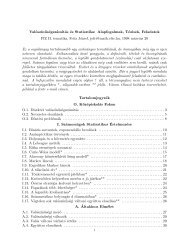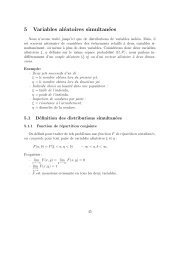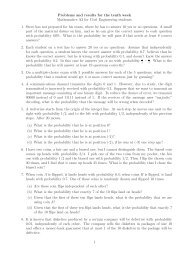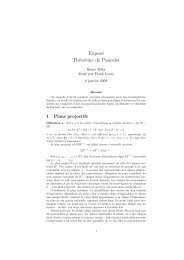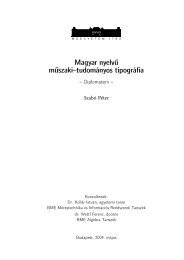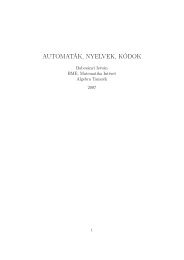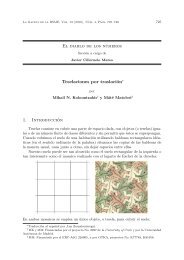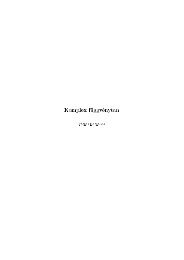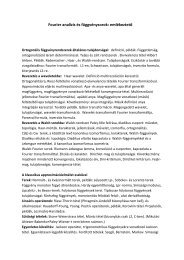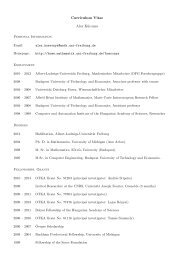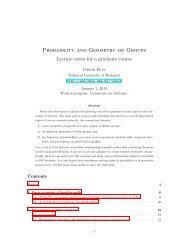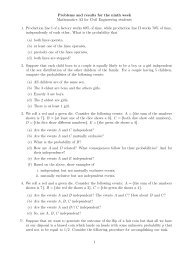John von Neumann, the Mathematician
John von Neumann, the Mathematician
John von Neumann, the Mathematician
Create successful ePaper yourself
Turn your PDF publications into a flip-book with our unique Google optimized e-Paper software.
The young <strong>Neumann</strong> János. (Photo from http://www.ysfine.<br />
com.wigner/neum/ymath.jpeg)<br />
His papers on set <strong>the</strong>ory and logic were published in<br />
1923 (1), 1925 (1), 1927 (1), 1928 (2), 1929 (1), and 1931<br />
(2). It is known that when he read about Gödel’s undecidability<br />
<strong>the</strong>orem in 1931, he dropped thinking seriously<br />
about this field. But <strong>the</strong>re was ano<strong>the</strong>r reason for that, too:<br />
starting at <strong>the</strong> latest from his scholarship in Göttingen in<br />
1926, his main interest had changed: it became centered<br />
around laying down <strong>the</strong> ma<strong>the</strong>matical foundations of<br />
quantum mechanics and hence around functional analysis.<br />
Ma<strong>the</strong>matical Foundations of Quantum Physics<br />
Hilbert certainly heard about <strong>the</strong> Hungarian Wunderkind<br />
quite early, and highly respected his results on set <strong>the</strong>ory and<br />
on Hilbert’s proof <strong>the</strong>ory. But in <strong>the</strong> mid-twenties, and very<br />
much in Göttingen, quantum mechanics was in <strong>the</strong> center of<br />
attention. Hilbert himself was strongly attracted to this disputed<br />
science. One should not forget that Göttingen was a<br />
center of quantum mechanics: Max Born (Nobel Prize 1954)<br />
and J. Franck (Nobel Prize 1925) were professors <strong>the</strong>re<br />
between 1921 and 1933 and between 1920 and 1933,<br />
respectively, and W. Heisenberg (Nobel Prize 1932) and W.<br />
Pauli (Nobel Prize 1945) also spent some years <strong>the</strong>re. In 1927,<br />
a long and important paper [HNvN27] on foundations of<br />
quantum mechanics of <strong>Neumann</strong> with Hilbert and L. Nordheim<br />
appeared. It also formulated a program that was later<br />
carried out in <strong>von</strong> <strong>Neumann</strong>’s book [vN32b].<br />
The program became a success story in many ways. It<br />
meant a victory for <strong>the</strong> Hilbert-space approach. Moreover,<br />
it attracted <strong>the</strong> attention of ma<strong>the</strong>maticians to <strong>the</strong> <strong>the</strong>ory of<br />
operators and to functional analysis. Also, by translating <strong>the</strong><br />
problems of quantum physics to <strong>the</strong> language of ma<strong>the</strong>matics,<br />
it formulated intriguing questions, which ei<strong>the</strong>r<br />
arose in physics or were generated by <strong>the</strong>m by <strong>the</strong> usual<br />
process of ma<strong>the</strong>matics. A substantial result of <strong>von</strong> <strong>Neumann</strong><br />
was <strong>the</strong> spectral <strong>the</strong>ory of unbounded operators,<br />
generalizing that given by Hilbert for bounded operators.<br />
Also, <strong>the</strong> language of operator <strong>the</strong>ory helped to reconcile<br />
<strong>the</strong> complementary and—apparently contradictory—<br />
approaches of Heisenberg and of Schrödinger.<br />
Von <strong>Neumann</strong>’s papers on <strong>the</strong> ma<strong>the</strong>matical foundations<br />
of quantum mechanics and functional analysis appeared in<br />
1927 (4), 1928 (5), 1929 (6), 1931 (2), 1932 (2), 1934 (2),<br />
1935 (3), and 1936 (1). I add that physicists appreciate, in<br />
particular, his <strong>the</strong>ories of hidden variables (more exactly, his<br />
proof of <strong>the</strong>ir nonexistence), of quantum logic, and of <strong>the</strong><br />
measuring process (cf. Geszti’s article in [BV]). From <strong>the</strong><br />
physical and also from gnoseological point of view I stress<br />
his disproof of <strong>the</strong> existence of hidden variables. The laws<br />
of quantum physics are by <strong>the</strong>ir very nature stochastic,<br />
basically contrary to <strong>the</strong> deterministic Laplacian view of <strong>the</strong><br />
universe. Several scholars, including Albert Einstein (his<br />
saying ‘‘God does not throw dice’’ became famous), did not<br />
accept a nondeterministic universe. There was a belief that<br />
probabilistic laws are always superficial and that behind<br />
<strong>the</strong>m <strong>the</strong>re must be some hidden variables, by <strong>the</strong> use of<br />
which <strong>the</strong> world becomes deterministic. This belief was<br />
irreversibly repudiated by <strong>von</strong> <strong>Neumann</strong>. 4<br />
Von <strong>Neumann</strong> writes in 1947 in an article entitled The<br />
Ma<strong>the</strong>matician [vN47], ‘‘It is undeniable that some of <strong>the</strong><br />
best inspirations of ma<strong>the</strong>matics—in those parts of it which<br />
are as pure ma<strong>the</strong>matics as one can imagine—have come<br />
from <strong>the</strong> natural sciences.’’ It is certainly undeniable that<br />
having shown ‘‘his lion’s claws’’ in set <strong>the</strong>ory, <strong>Neumann</strong> got<br />
to <strong>the</strong> right place: To elaborate <strong>the</strong> ma<strong>the</strong>matical foundations<br />
of quantum mechanics was <strong>the</strong> best imaginable<br />
challenge for <strong>the</strong> young genius. The completion of this task<br />
led to a victorious period for functional analysis, <strong>the</strong> <strong>the</strong>ory<br />
of unbounded operators. Von <strong>Neumann</strong> kept up this<br />
interest until his death. Peter Lax remembers, ‘‘I recall how<br />
pleased and excited <strong>Neumann</strong> was in 1953 when he<br />
learned of Kato’s proof of <strong>the</strong> self-adjointness of <strong>the</strong><br />
Schrödinger operator for <strong>the</strong> helium atom.’’ [Lax].<br />
Von <strong>Neumann</strong>, being a true ma<strong>the</strong>matician, was also<br />
aware of <strong>the</strong> o<strong>the</strong>r fundamental motivation of a ma<strong>the</strong>matician.<br />
In <strong>the</strong> same 1947 article [27] he starts, ‘‘I think it is a<br />
relatively good approximation to truth ... that ma<strong>the</strong>matical<br />
ideas originate in empirics, although <strong>the</strong> genealogy is<br />
sometimes long and obscure.’’ Then he continues, ‘‘But,<br />
once <strong>the</strong>y are so conceived, <strong>the</strong> subject begins to live a<br />
peculiar life of his own and is better compared to a creative<br />
one, governed by almost entirely aes<strong>the</strong>tical motivations,<br />
than to anything else and, in particular, to an empirical science.’’<br />
I can not resist adding one more idea of <strong>von</strong><br />
<strong>Neumann</strong> about his favourite criterion of elegance: ‘‘One<br />
expects from a ma<strong>the</strong>matical <strong>the</strong>orem or from a ma<strong>the</strong>matical<br />
<strong>the</strong>ory not only to describe and to classify in a simple<br />
and elegant way numerous and a priori special cases. One<br />
also expects ‘elegance’ in its ‘architectural’ structural<br />
makeup. Ease in stating <strong>the</strong> problem, great difficulty in<br />
getting hold of it and in all attempts at approaching it, <strong>the</strong>n<br />
again some very surprising twist by which <strong>the</strong> approach<br />
becomes easy, etc. Also, if <strong>the</strong> deductions are lengthy or<br />
4<br />
I learnt from Peter Lax that <strong>von</strong> <strong>Neumann</strong> made a subtle error about hidden variables. It was fixed up by S. Kochen and E. P. Specker in J. of Math.& Mech. 17 (1967),<br />
59-87. Editor’s note: This issue remains contentious, and will be revisited in a future issue of The Ma<strong>the</strong>matical Intelligencer.<br />
THE MATHEMATICAL INTELLIGENCER



